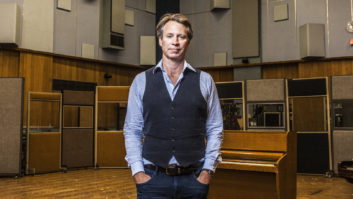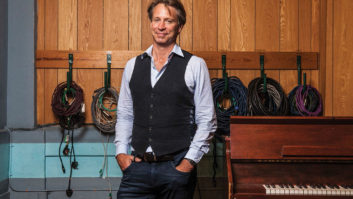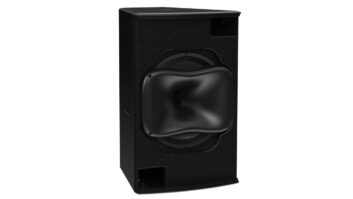As a Presenting Partner of the London 2012 Olympic Torch Relay, Coca Cola has been staging special concerts at five locations across the country featuring live performances from some of the UK’s top music artists.
These celebrations have coincided with the journey of the Olympic Flame as it travels around the country while also honoring the achievements of local Future Flames––inspirational teens selected by Coca Cola to become Olympic Torchbearers for London 2012.
RG Jones Sound Engineering has been providing audio production support at all but the London event with their newly acquired Martin Audio Multicellular Loudspeaker Array (MLA) system.
Under the project management of Steve Carr, they fielded PA hangs and control in Birmingham, Cardiff, Glasgow and Leeds, helping to enhance such headline acts as The Wanted, Friendly Fires, Eliza Doolittle, Dizzee Rascal and You Me At Six— and a special guest appearance by Emeli Sandé at two of the events.
The company was working alongside a production company specializing in branded musical festivals—and technical director Ben Price of WNY, with whom they have collaborated on high profile events in the past.
Steve Carr confirmed that the acquisition of their new MLA system had conveniently coincided with winning this contract. “It then became a no brainer to launch it on these shows,” he said. “With high profile bands appearing at each event, it was an opportunity to showcase it to a number of FOH engineers, all of whom wanted to experience this pioneering system … and we received great response back.”
One of the most positive FOH engineers was Andrew Thornton, who mixed The Wanted’s sound to up to 20,000 people gathered at Birmingham’s Cannon Hill Park.
Thornton’s first encounter with MLA had been at the Roundhouse iTunes Festival back in 2010 (with Pixie Lott) but working outdoors gave him a whole new perspective. “MLA stands in comparison with the best I have used,” he confirmed. “It was very impressive … particularly how much low end there was in the main array. It sounded modern, clean and hi-fi — and it stood up particularly well to the wind, which is always a challenge. I put my Profile show file straight into the system and the mix required almost no EQ.”
RG Jones fielded an identical main PA configuration at all four sites, with 14 elements of MLA each side of the stage. In Birmingham—where Sir Cliff Richard handed over the Olympic Torch to Kiran Sahota—they also fielded six Martin Audio W8LC outfills and a delay mast with eight W8LCs set back 393 feet––highlighting another great feature of this groundbreaking system. The ability to create a coherent soundfield that drops in level by a mere 3dB over that kind of distance is unprecedented, and has very favorable implications for promoters when considering the impact of delay towers on audience areas.
In fact such was the throw distance of MLA on a site that stretched back around 656 feet, that it rendered the delay position almost redundant.
RG Jones also fielded 14 MLX subs in broadside configuration along the stage apron, split into two pairs of seven to allow steps up the center of the stage for the Olympic torchbearer.
“Having the subs in this configuration gave us greater width––and great projection,” summarized Carr. “I was also very surprised by the throw distance of the MLA itself — I simply didn’t believe such a smooth sound was possible over that distance. We checked at 393 feet and 492 feet, and it maintained its body, detail and structure with no variation.”
“We were averaging around 98-100dB over 15 minutes—which delivered both the FOH engineers’ and audience expectations and provided us with the opportunity to put the system through its paces outside,” Carr added.
The Birmingham show (as with the others) presented a versatile program to test the system, ranging from street dance to the Birmingham Royal Ballet, R&B artist Loick Essien and rock band Morning Parade, before the arrival of the Torch and closure by The Wanted.
With Mark Edwards, now a seasoned MLA system tech, plotting the curves, Steve Carr said he was always confident that the high expectations would be delivered. “This meant achieving consistent, even, high quality coverage — which the MLA did.
“I’m consistently impressed by its performance and more and more convinced by the power and quality,” he concluded. “The first time I heard [MLA] outdoors it felt very different. When I started to listen to instruments through it I suddenly noticed the detail that I wouldn’t normally have had my attention drawn to … the sensation of listening with my eyes closed was like listening to a set of nearfield monitors!”
Photo captions: Steve Carr and Mark Edwards, Steve Carr (foreground) mixing
For more about Martin Audio, please click to www.martin-audio.com.
About MLA™ (Multi-cellular Loudspeaker Array)
The result of many years of intensive R&D, MLA’s methodology replaces trial-and-error array design with intelligent numerical optimization of the array’s output based on a highly accurate acoustic model. The multi-cellular format has six individual cells in each enclosure, each with its own DSP and amplification.
With up to 24 enclosures, each MLA array has up to 144 cells — too great a number to optimize manually, or by ear. Instead, Martin Audio’s proprietary Display2™ system design software automatically calculates FIR DSP filters for each cell and a redundant-ring audio network (U-NET™) downloads the settings into each array enclosure. Martin Audio’s VU-NET™ software provides real-time control and monitoring of the system.
MLA delivers a frequency response and SPL consistency never before achievable; a very high system output (140dB peak, per cabinet @1m); Automatic optimization of the array, both physically (splay angles) and electronically (DSP); Computer control and monitoring of the entire system, and total control of sound system balance for engineers and sound technicians.
MLA is fully integrated, with Class D amplification, DSP and U-NET digital audio
network built into each enclosure. MLA complete systems are ready-to-use, with MLA, MLD and MLX enclosures, flying hardware, software, cabling and training all supplied. Everything needed is included. All ancillary items — from tablet PC and Merlin™ controller to network interconnects and mains distro — are also included in the complete system package. This ensures full compatibility worldwide, down to cabling and accessories.
Additional features include 90° x 7.5° dispersion; a compact size (1136mm wide x 372mm high x 675mm deep), one-box-fits-all (festivals to theaters) application range and a global voltage, power factor corrected power supply.
MLA’s compact size and very high output allows it to be shipped using smaller trucks, offering considerable savings and reduced carbon footprint. The system also includes the MLX powered, flyable subwoofer capable of an unprecedented measured peak output of 150dB @ 1m; MLD downfill cabinet, and Merlin 4-in/10-out system controller and network hub. Audio input is via analog, AES3 or U-NET.
By adopting these principles and system components MLA is optimized for every member of the audience — from a 2,000 capacity theater, to a 20,000-seat arena, to a 100,000-person festival site. It will deliver the engineer’s exact mix to every seat (up to over 150 meters) with precision, exceptional power and clarity.
About Martin Audio®
Founded by audio engineer David Martin in 1971, Martin Audio pioneered the use of all-horn-loaded bass designs in world-class touring loudspeaker systems for groups such as Pink Floyd, ELP and Supertramp. Located outside of London, Martin Audio now embodies a sophisticated mix of acoustic design, research, mathematical modeling and software engineering for a wide range of products in the installation, cinema and touring sound markets.







